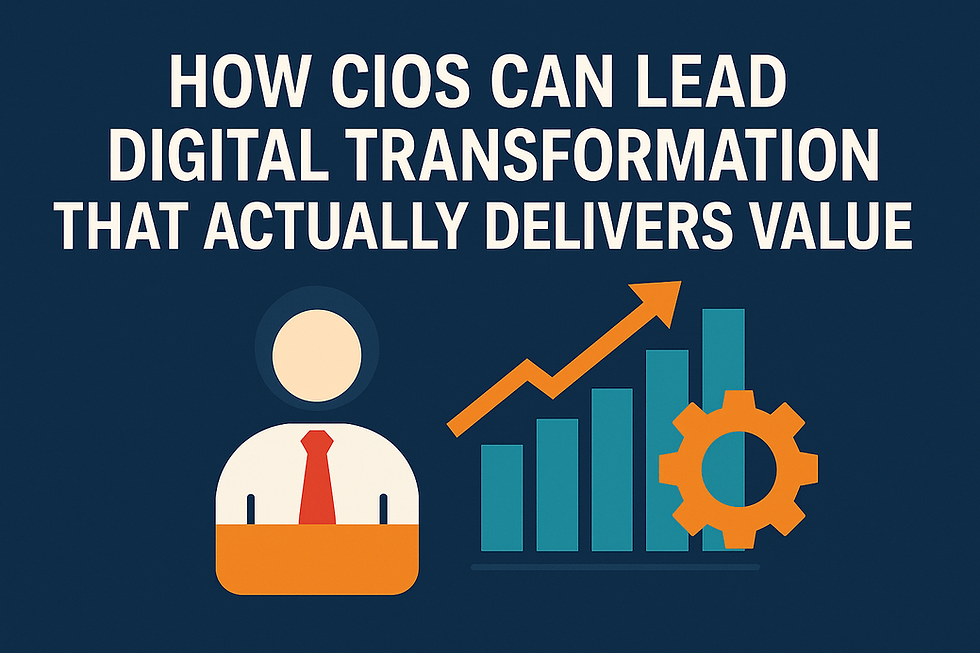How CIOs Can Lead Digital Transformation That Actually Delivers Value
- Richard Keenlyside
- 1 day ago
- 3 min read
Introduction: Transformation Must Mean Tangible Results
Digital transformation has become one of the most overused and misunderstood terms in business. Many organisations embark on multi-million-pound programmes that promise revolutionary change yet fail to deliver measurable outcomes.
As CIOs, our role isn’t simply to implement new technology. It’s to ensure every investment directly supports growth, efficiency, and resilience. Having led global transformation programmes across the UK, US, and UAE, I’ve seen that success comes down to three core principles: governance, clarity, and accountability.

1. Build Governance Before You Buy Technology
True transformation begins with governance, not gadgets. A well-defined governance framework ensures every project has:
Clear ownership and business sponsorship
Defined KPIs linked to strategic outcomes
Stage-gated approval and benefits tracking
At Intology, we start every engagement by mapping existing maturity against recognised standards such as ISO 27001, NIST CSF, and COBIT 2019. This not only protects the organisation’s investment but accelerates decision-making by removing ambiguity.
2. Align Technology with Business Value
Too often, transformation is IT-led rather than business-driven. CIOs must translate complex technical capabilities into commercial language that boards understand.
Ask three questions before approving any major initiative:
What business metric will this improve?
How will we measure success within 90 days?
What happens if we do nothing?
For example, in one manufacturing ERP consolidation, aligning KPIs to revenue per FTE and working-capital days reduced costs by 38 per cent and delivered ROI within 18 months.
3. Prioritise Cybersecurity and Compliance
As digital ecosystems expand, so does the attack surface. Every new platform, supplier, and API introduces potential risk. Modern transformation cannot exist without cyber resilience baked in.
Embedding cybersecurity early — through risk registers, data-classification policies, and ISO 27001 controls — prevents disruption later. In today’s regulatory environment (GDPR, NIS2, and supply-chain due diligence), compliance isn’t optional; it’s competitive advantage.
4. Empower People to Embrace Change
Technology adoption succeeds or fails based on culture. CIOs must act as chief storytellers, translating strategy into behaviour.
Effective change management means:
Communicating why the change matters
Involving end users in solution design
Measuring adoption through engagement analytics
At Intology, we integrate digital adoption metrics into our PMO dashboards so executives see culture and capability evolve in real time.
5. Measure, Learn, and Iterate
Transformation is not a one-off event — it’s a continuous feedback loop. Use data to drive refinement:
Track benefits realisation quarterly
Benchmark maturity annually against ISO/NIST frameworks
Celebrate quick wins to maintain momentum
Success isn’t just system go-live; it’s measurable performance improvement across finance, operations, and customer experience.
Key Takeaways
Governance first: Define controls before deploying technology.
Business alignment: Link every project to measurable value.
Cyber resilience: Secure transformation is sustainable transformation.
People and culture: Lead with empathy and clarity.
Continuous improvement: Use analytics to inform next-stage investments.
My Final Thoughts
CIOs today sit at the intersection of strategy, technology, and change. Those who balance innovation with governance will define the next decade of enterprise success.
If you’re planning a major transformation or need to realign digital strategy with measurable outcomes, let’s talk.
Call to Action
Book a strategic consultation with Richard Keenlyside or explore the Intology Transformation Playbook for proven frameworks that deliver measurable business value.
Written by Richard Keenlyside – Global CIO, Transformation Director & Governance Advisor. Follow Richard on LinkedIn or X @CIOinPractice.




Comments